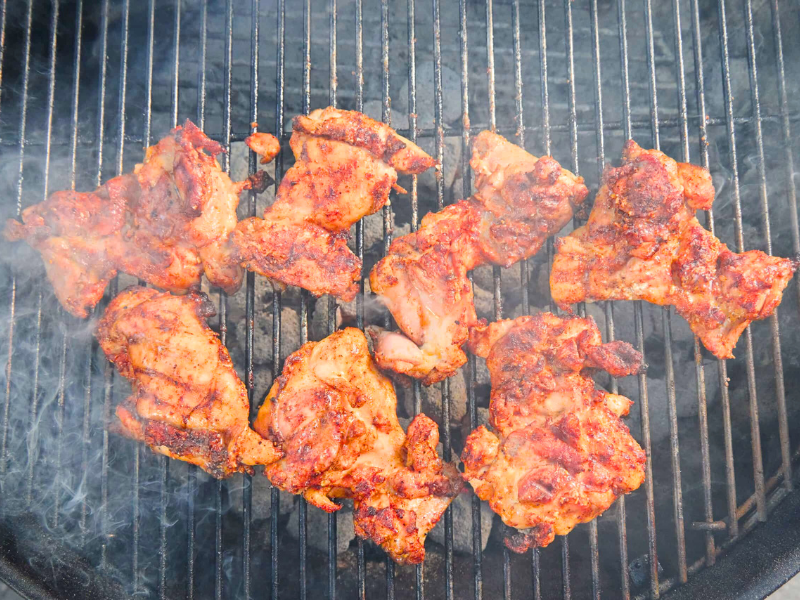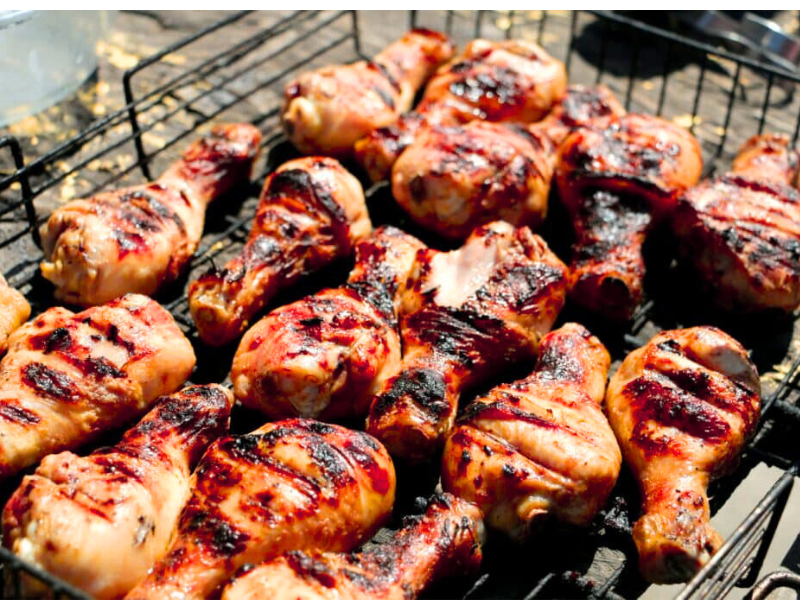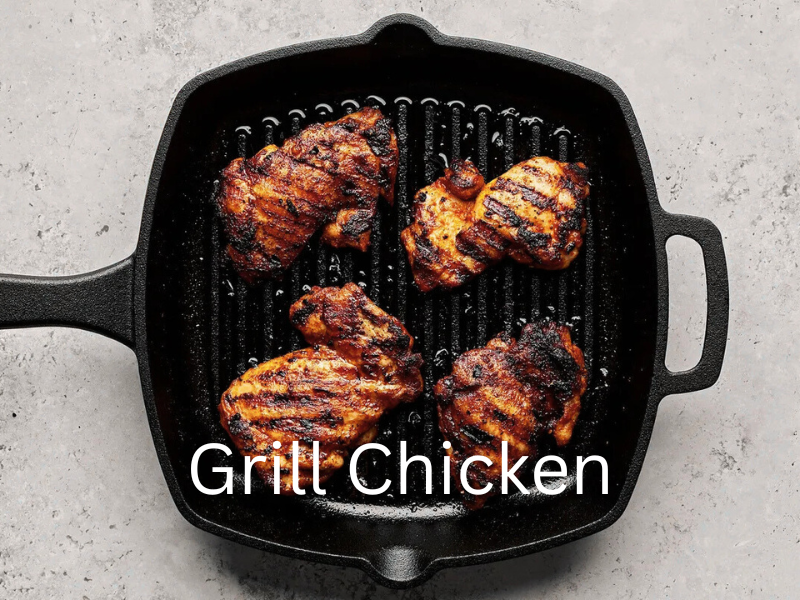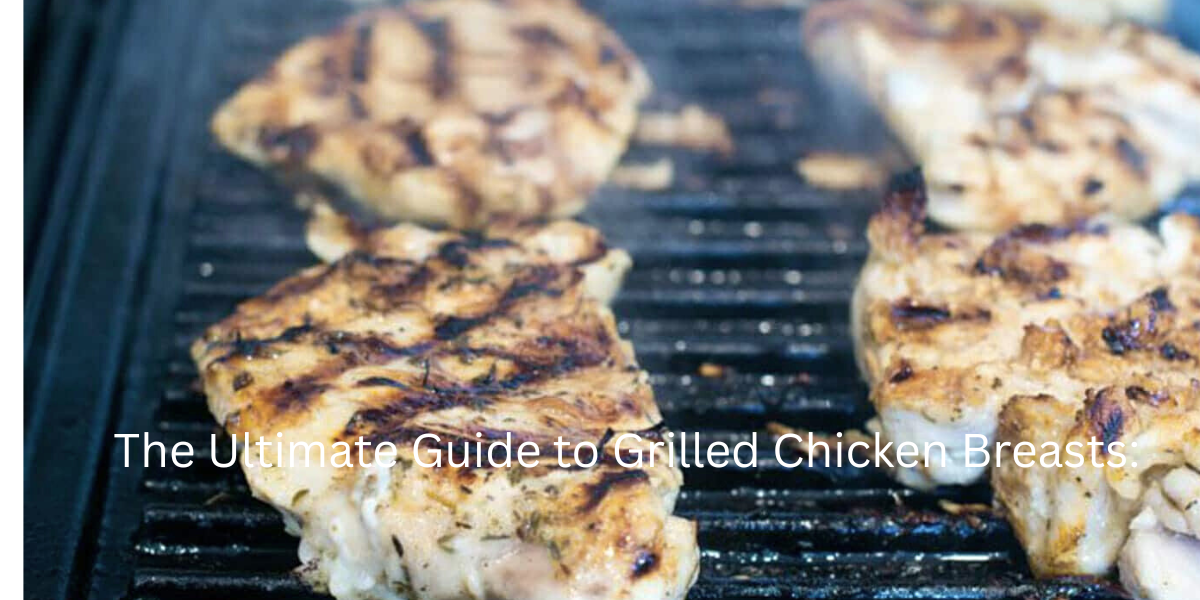Introduction
Grilled chicken thighs are a crowd-pleaser. Grilled Chicken Thighs Guide: Time, known for its juicy, tender meat and rich flavor. Unlike chicken breasts, thighs have more fat, which keeps them moist even on the grill. If you’ve ever wondered how long to grill chicken thighs or what the best marinade is, you’re in the right place.
After 15 years of grilling and testing hundreds of chicken thigh recipes, I’ve discovered the exact techniques that guarantee perfectly juicy results every time. As a certified BBQ judge and culinary school graduate, I’ve made every mistake in the book—from rubber-textured over-marinated thighs to charred-outside, raw-inside disasters—so you don’t have to.
This guide breaks down everything you need to know—ideal grilling times for boneless and bone-in chicken thighs, plus easy marinades that bring out the best flavors. Whether you’re grilling for a casual backyard BBQ or a quick weeknight dinner, mastering the perfect grilling technique will have you serving up juicy, flavorful chicken every time. These are the same methods I use when catering events for 200+ people, scaled down for your home grill. Ready to learn the secrets to perfectly grilled chicken thighs? Let’s dive in!
How Long to Grill Chicken Thighs (Bone-In vs Boneless)
Getting the timing right is crucial for perfectly grilled chicken thighs. The cooking time varies significantly depending on whether you’re working with bone-in or boneless cuts. In my professional kitchen experience, I’ve found that precise timing prevents the #1 mistake home cooks make: overcooking thighs into leather.

Boneless, Skinless Chicken Thighs:
Grilling time: 5-7 minutes per side over medium-high heat
Total cooking time: 10-14 minutes
These cook faster due to their uniform thickness and lack of bone
Bone-In, Skin-On Chicken Thighs:
Grilling time: 7-10 minutes per side over medium heat
Total cooking time: 14-20 minutes
The bone acts as an insulator, requiring longer cooking times
Internal Temperature for Doneness: Regardless of the cut, chicken thighs are perfectly done when they reach an internal temperature of 165°F (74°C). However, thighs can handle slightly higher temperatures without drying out—up to 175°F (79°C) will still yield juicy meat.
Pro Tip: Use a meat thermometer correctly by inserting it into the thickest part of the thigh, avoiding the bone. For bone-in thighs, angle the thermometer so it doesn’t touch the bone, which can give false readings. I recommend the ThermoWorks Thermapen—after using dozens of thermometers in professional kitchens, it’s the most accurate and fastest-reading option I’ve found.
Choosing the Right Cut: Boneless vs Bone-In Chicken Thighs
Understanding the differences between cuts helps you make the best choice for your grilling needs. Having worked with both cuts in restaurant settings and home kitchens, I’ve learned when each type performs best.
Flavor and Texture Differences: Bone-in, skin-on thighs deliver the most flavor and moisture. The bone helps retain heat and keeps the meat tender, while the skin becomes beautifully crispy when grilled properly. Boneless, skinless thighs cook more evenly and are easier to eat, though they require more attention to prevent overcooking.
When to Use Each:
Bone-in thighs: Perfect for BBQ gatherings, weekend grilling, and when presentation matters. They’re more forgiving if you’re new to grilling.
Boneless thighs: Ideal for meal prep, quick weeknight dinners, and when you want uniform cooking. They’re also easier for marinades to penetrate fully.
Skin-On vs Skinless Grilling Behavior: Skin-on thighs create more flare-ups due to rendered fat, but reward you with crispy skin and extra flavor. Start them skin-side down over medium heat to render the fat slowly. Skinless thighs are leaner and less likely to cause flare-ups, making them easier for beginners.
Best Marinade for Grilled Chicken Thighs
A great marinade transforms ordinary chicken thighs into extraordinary meals. The key is balancing four essential components. After developing over 50 marinade recipes for my catering business, I’ve perfected this formula that works every time.
Basic Marinade Formula:
Oil (2-3 tablespoons): Helps prevent sticking and carries flavors
Acid (2-3 tablespoons): Lemon juice, vinegar, or wine tenderizes meat
Aromatics: Garlic, herbs, spices for flavor depth
Sweetener (1-2 tablespoons): Honey, maple syrup, or brown sugar for caramelization
Three Crowd-Pleasing Marinade Recipes:
These recipes have been tested in my kitchen hundreds of times and consistently earn rave reviews from clients and family alike.
Lemon-Garlic Herb Marinade:
3 tablespoons olive oil
3 tablespoons fresh lemon juice
4 garlic cloves, minced
2 tablespoons fresh rosemary, chopped
1 tablespoon honey
Salt and pepper to taste
Honey-Soy-Ginger Marinade:
3 tablespoons vegetable oil
3 tablespoons soy sauce
2 tablespoons honey
1 tablespoon rice vinegar
2 teaspoons fresh ginger, grated
2 garlic cloves, minced
1 teaspoon sesame oil
Maple Mustard Balsamic Marinade:
3 tablespoons olive oil
2 tablespoons balsamic vinegar
2 tablespoons maple syrup
1 tablespoon Dijon mustard
2 garlic cloves, minced
1 teaspoon dried thyme
Salt and pepper to taste
How Long to Marinate: Marinate chicken thighs for 2-24 hours in the refrigerator. The minimum effective time is 30 minutes, but 2-4 hours delivers optimal flavor penetration. Over-marinating (beyond 24 hours) can break down the meat’s texture, especially with acidic marinades, resulting in mushy chicken. I learned this lesson the hard way during my early catering days when I left chicken in lemon marinade for 48 hours—it turned into complete mush!
Step-by-Step Grilling Instructions
Proper technique ensures evenly cooked, flavorful chicken thighs every time. These steps follow the exact process I use for competition BBQ and professional catering.

Preheating and Preparation: Preheat your grill to medium heat (350-400°F) for 10-15 minutes. Clean the grates thoroughly with a grill brush, then oil them using a paper towel dipped in vegetable oil and held with tongs. This prevents sticking and creates beautiful grill marks.
Direct vs Indirect Heat:
Direct heat: Place chicken directly over the flame for searing and cooking thinner, boneless cuts
Indirect heat: Position chicken away from direct flame, ideal for thicker, bone-in pieces that need gentle, even cooking
For bone-in thighs, start with 2-3 minutes of direct heat for searing, then move to indirect heat to finish cooking. Boneless thighs can be cooked entirely over direct medium heat.
When and How to Flip: Flip chicken thighs only once during cooking. For bone-in thighs, flip after 7-8 minutes when the first side releases easily from the grates. For boneless thighs, flip after 5-6 minutes. Resist the urge to flip multiple times—this prevents proper searing and can cause the meat to stick.
Lid Management: Keep the lid closed as much as possible to maintain consistent temperature and create an oven-like environment. Open only to flip the chicken or check doneness. Frequent lid opening causes temperature fluctuations and extends cooking time. This is one of the biggest differences between amateur and professional grilling—patience with the lid creates consistently better results.
Expert Tips to Avoid Dry or Overcooked Chicken
Learn from common mistakes to achieve perfect results every time. These insights come from years of troubleshooting both my own grilling mistakes and helping hundreds of students in my BBQ classes.
Common Mistakes People Make: The biggest error is cooking over too high heat, which burns the outside while leaving the inside undercooked. Another mistake is moving the chicken too frequently—let it cook undisturbed to develop proper searing. Finally, many people don’t account for carryover cooking, pulling chicken off the grill too late.
The Importance of Letting Meat Rest: After grilling, let chicken thighs rest for 5-10 minutes before cutting. This allows juices to redistribute throughout the meat, preventing them from running out when sliced. Tent loosely with foil to keep warm during resting.
Carryover Cooking Explained: Chicken continues cooking even after leaving the grill due to residual heat. Remove thighs from the grill when they reach 160°F (71°C)—they’ll reach the safe 165°F (74°C) during resting. This technique prevents overcooking and ensures juicy results. I discovered this principle during my culinary training, and it’s been a game-changer for achieving consistent results under pressure.
Side Dishes That Pair Perfectly with Grilled Chicken Thighs
Complete your meal with complementary sides and beverages that enhance the chicken’s flavors. These pairings are based on flavor science principles I learned in culinary school and refined through years of menu development.
Grilled and Fresh Sides: Grilled vegetables like zucchini, bell peppers, and corn on the cob share the same smoky notes as the chicken. Herbed rice pilaf or quinoa provides a neutral base that absorbs the chicken’s flavorful juices. Summer slaw with a tangy vinaigrette offers a refreshing contrast to rich, grilled meat. Garlic bread or grilled flatbread rounds out the meal with satisfying carbs.
Beverage Pairings: Fresh lemonade or iced tea complements the smoky flavors without competing. For adult beverages, light beers like pilsners or wheat beers work beautifully, while wine lovers should consider Pinot Grigio, Sauvignon Blanc, or light red wines like Pinot Noir. These drinks cleanse the palate between bites.
What To Do With Leftovers
Transform leftover grilled chicken thighs into new meals throughout the week. As someone who meal preps professionally, I’ve mastered the art of making leftovers taste fresh and exciting.
Creative Leftover Ideas: Slice cooled chicken for wraps with fresh vegetables and your favorite sauce. Dice it for hearty salads with mixed greens, cherry tomatoes, and vinaigrette. Create grain bowls by combining chicken with quinoa, roasted vegetables, and tahini dressing. The rich flavor of grilled thighs also works perfectly in quesadillas, pasta salads, or chicken salad sandwiches.
Storage and Reheating Tips: Store leftover chicken in the refrigerator for up to 4 days in airtight containers. To reheat without drying out, wrap portions in damp paper towels and microwave in 30-second intervals, or reheat gently in a covered skillet over low heat with a splash of chicken broth. For meal prep, slice chicken while warm and store with a bit of the pan juices to maintain moisture.
Frequently Asked Questions (FAQ)
Can I grill frozen chicken thighs? It’s not recommended to grill frozen chicken thighs directly. Thaw them completely in the refrigerator (24-48 hours) before grilling. Frozen chicken cooks unevenly, with the outside potentially burning before the inside reaches safe temperatures. I’ve seen this mistake countless times in my BBQ classes—it always results in disappointing chicken.

What’s the best oil to use for grilling? Use oils with high smoke points like vegetable oil, canola oil, or avocado oil for grilling. Olive oil works for marinades, but it can smoke at high temperatures. Apply oil to the grates, not directly to the chicken, to prevent flare-ups. After testing dozens of oils in professional kitchens, avocado oil is my top choice for its clean flavor and high smoke point.
Should I score the chicken before marinating? Scoring (making shallow cuts) isn’t necessary for chicken thighs and can cause them to dry out by allowing juices to escape. The naturally tender texture of thighs allows marinades to penetrate effectively without scoring. This goes against what many home cooks think, but I’ve tested this extensively—unscored thighs retain more moisture.
Conclusion
Mastering grilled chicken thighs comes down to understanding timing, temperature, and technique. Remember that bone-in thighs require 14-20 minutes of cooking time, while boneless thighs require only 10-14 minutes. Always cook to an internal temperature of 165°F, and remember the importance of resting your meat.
The marinade recipes provided will elevate your grilling game, but feel free to experiment with your flavor combinations using the basic formula. These techniques have enabled me to serve thousands of perfectly grilled chicken thighs throughout my career, and I’m confident they’ll work for you too.
Trust the process, use a reliable thermometer, and remember that practice makes perfect. With these techniques and tips, you’ll consistently produce juicy, flavorful chicken thighs that’ll have everyone asking for more.
Ready to fire up the grill? Try one of the marinade recipes this weekend and let us know how it turns out. I read and respond to every comment—share your grilling successes in the comments below, and don’t forget to save this guide for your next BBQ adventure!

